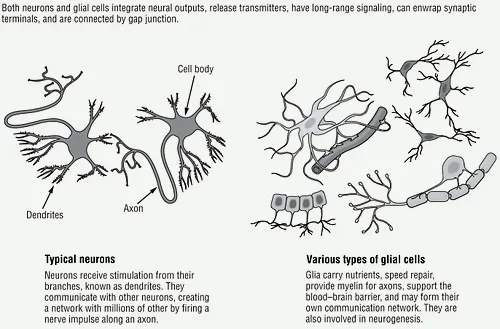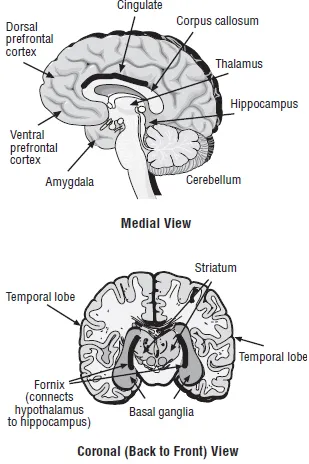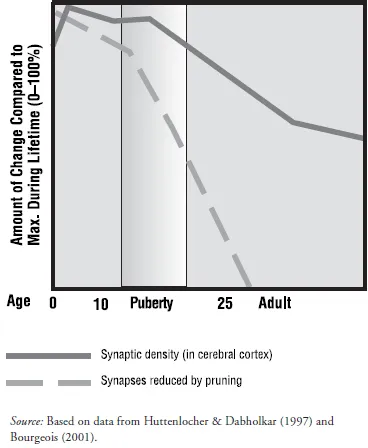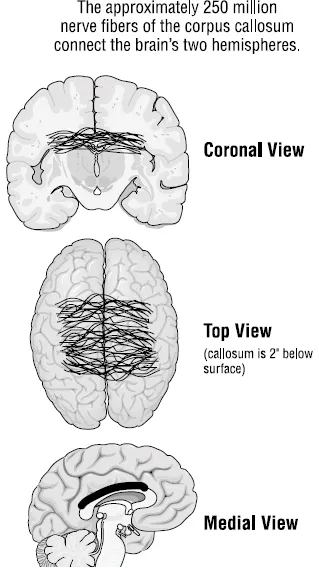![]()
Chapter 1
Meet Your Amazing Brain
Key Concepts
- Basic brain anatomy
- How the brain changes over time
- Cooperation and competition in the brain
- How the brain learns
You’ve heard for much of your life that the human brain is amazing. It’s true. That soft, squishy blob between your ears—the blob that runs your life—is pretty amazing. Every day in classrooms around the world, teachers are amazed by what the human brain can do. Because exploring all the facets of the brain is beyond the scope of this chapter, we’ll focus on three relevant and essential features:
- Adaptability. The brain changes constantly.
- Integration. Brain structures compete and cooperate.
- Sophistication. The brain is highly complex.
These themes help to establish the nature of the brain: it is constantly working; it operates with a high level of structural cooperation; and seemingly simple processes, like learning to read, are actually highly complex. This dynamic and versatile structure is unlike anything else on earth. That may be why we are so attracted to the study of the brain—it evokes both wonder and curiosity. At the simplest level, the brain is an organ that we are all born with, and we’ll explore that concept first. But the brain is much more than an anatomical structure; it is also an active processing center, always at work.
The Raw Material
To begin learning about the brain, consider a grocery store’s produce and dairy departments. In shape, the brain closely resembles a head of cauliflower. In size, it’s similar to a large grapefruit or cantaloupe (see Figure 1.1). The brain is mostly water (78 percent), fat (10 percent), and protein (8 percent). From the outside, the brain’s most distinguishing features are its convolutions, or folds. The wrinkles are part of the cerebral cortex (Latin for “bark” or “rind”), the brain’s outer covering. The cerebral cortex is about as thick as an orange peel. The folds allow the covering to maximize its surface area (have more cells per square inch). In fact, if the cortex were laid out flat, it would be about the size of an unfolded, single page from a daily newspaper. Remember, the brain is only a grapefruit-sized organ. It’s general texture is about the same as soft butter, but some parts are as gooey as raw eggs or yogurt.
Figure 1.1. The Human Brain
Brains have both neurons and glial cells (see Figure 1.2). The most well-studied brain cells are neurons, which consist of a cell body with fingerlike input extensions, called dendrites, and a single output, called an axon. Neurons have different shapes depending on the part of the brain they’re in and their function. There are many types of glial cells, each with different functions. Recently, scientists have discovered that glia—also known as interneurons—are not, as once thought, just a “support” or “housekeeping” cell, but are quite important in brain development, function, and growth.
Figure 1.2. Neurons and Glial Cells
Estimates vary on the actual number of neurons and glia in the human brain. One researcher who has done detailed studies in this area, William Shankle of the University of California-Irvine, asserts the human brain has about 30 to 50 billion neurons. His studies (Landing, Shankle, Hara, Brannock, & Fallon, 2002) also show a 20 to 40 percent variance among humans, meaning the real numbers vary by billions from one person to another. No wonder differentiation in teaching makes sense!
A more mainstream view is that we’re born with about 150 to 200 billion neuron cells and keep about 100 billion of them. (The rest disappear for various reasons, as explained later.) By the time we’re adults, we also have about 500 billion to 1,000 billion glial cells. For the sake of comparison, a fruit fly has 100,000 neurons, a mouse has 5 million, and a monkey has 10 billion. A single cubic millimeter (1/16,000th of an inch) of human brain tissue has more than 1 million neurons.
Humans have large brains relative to body weight. The adult human brain weighs about three pounds (1,300–1,400 grams). But would a bigger brain make you smarter? That’s unlikely. A sperm whale’s brain weighs about 17 pounds, or 7,800 grams.
The brain’s various parts and its nerve cells are connected by nearly 1 million miles of nerve fibers. The human brain has the largest area of uncommitted cortex (with no specific function identified so far) of any species on earth. This gives humans extraordinary flexibility for learning.
Scientists divide brain areas into lobes (see Figure 1.3). The occipital lobe is in the middle-back area of the brain, and it’s primarily responsible for vision. The temporal lobes are located above and around the ears on the left and right sides of the brain. These areas are primarily responsible for hearing, memory, and language. Connect visual areas to language areas, and you can “see” what you hear and say. That’s part of the essence of reading: high visual-auditory connectivity. The frontal lobe is the area around your forehead. It’s involved with purposeful activities like judgment, creativity, problem solving, and planning. It also holds short-term memory so you can juggle two or more thoughts at once. The parietal lobe is at the top and back areas of your head. Its duties include processing higher sensory and language functions. It also has a cool tie-in with the Sci Fi Channel in that it’s highly active in subjects who claim to have seen hallucinations or UFOs, or have had “near death” experiences.
Figure 1.3. Main Areas of the Human Brain
The territory in the middle of the brain includes the hippocampus, thalamus, hypothalamus, cingulate, basal ganglia, fornix, striatum, and amygdala (see Figure 1.4). You could call this area both the chemistry lab and the drama department of the brain. Sometimes known as the limbic system, it represents 20 percent of the brain by volume and is partly responsible for emotions, sleep, attention, body regulation, hormones, sexuality, sense of smell, and production of many brain chemicals. However, noted neuroscientist Joseph LeDoux (1996) contends that there is no real “limbic system,” only specific structures that process emotion, such as the amygdala. In either case, this middle area of the brain, along with the parts of the cortex, helps you feel what you feel about the world.
Figure 1.4. Medial and Coronal Views of the Brain
The location of the brain area that allows you to know that you are “you” (consciousness) is disputed. It may be dispersed throughout the cortex, or it may be in the thalamus, or it may be located near the reticular formation, a structure atop the brain stem (Crick, 1994). You’d think that this part of the brain would be easy to find—just cut away brain areas until a person loses awareness, right? But it’s not just a simple case of Jack the Ripper meets the Nutty Professor. Remember, the second essential feature of the brain is integration, or strong connectivity. That means many areas connect to and influence other portions, so that specific sections of the brain may contribute separately and collectively to your sense of self. In short, one critical quality that makes the brain work so well is its degree of connectivity, not its individual structures.
Adaptability: The Constantly Changing Brain
Not long ago, the prevailing view of the brain was that it remained fairly constant throughout a person’s life. We knew that the brain was smaller in childhood; once it reached maturity, we thought it remained more or less stable over many years before beginning to deteriorate somewhat with age. This view of a “static” brain is decidedly out of date. Yes, the most amazing new discovery about the brain might be that human beings have the capacity and the choice to be able to change our own brains.
It’s now understood that environmental events at one level of an organism (molecules, cells, organs, systems, individual behavior, society) can profoundly influence events at other levels (Cacioppo, Berntson, Sheridan, & McClintock, 2001). This finding suggests that your experiences and the actions you take can lead to changes in your brain. These changes, in turn, change you. We also know that your life influences your genes at the same time that your genes regulate your life. Researchers have found evidence of social influence on both genetic constitution (Reik, Dean, & Walter, 2001; Wilson & Grim, 1991) and genetic expression (Suomi, 1999)—meaning the substance of the genes and how the genes function. New evidence suggests that environmental triggers, even things like stress (Foster & Cairns, 1994), can “reprogram” our genes. In short, we can and do influence our own genetic material; this is a profound revelation!
The result of the various interrelation of humans shaping environments and environments shaping humans is that there is no fixed human brain; it is always a work in progress. Another way to put it is that your brain is dynamic and constantly changing as a result of the world you live in and the life you lead. Whether you are 2 or 92, your brain is a cauldron of changing chemicals, electrical activity, cell growth, cell death, connectivity, and change.
This dynamism makes it very challenging to get clear data on what’s happening in the brain. From birth to the teenage years, the brain undergoes a fourfold increase in volume (Johnson, 2001). Infants are born with roughly a trillion connections (synapses) already in place. The infant’s interaction with his or her environment helps create many additional connections within the cortex. At the same time, the genetic process called “pruning” eliminates countless unnecessary connections. Throughout life, your brain is losing connections at the same time it is creating new connections. It’s a bit like going out shopping for new clothes at the same time that someone is raiding your closet back at home. This ongoing refinement results in a highly adapted, highly specialized brain (see Figure 1.5).
Figure 1.5. Constant Change in the Brain from Birth Through Adulthood
Longtime neuroscience dogma held that the mammalian brain couldn’t grow new brain cells, and mainstream science was absolutely certain that new brain cell growth (neurogenesis) was impossible in the human brain. However, the ground-breaking research of Kempermann, Kuhn, and Gage (1998) showed not only that humans do grow new neurons, but also that these new cells survive and become functional and integrated. Just as important, a follow-up study (Van Praag et al., 1999) found that humans can influence the rate of new brain cell growth. In fact, researchers have identified more than 15 factors that either enhance or impair neurogenesis. Again, the complexity of the brain comes into play. Although factors such as excess stress can inhibit growth, exercise can encourage it, as we’ll see in later chapters. All of this paints a complex picture of what exactly you have in your brain at any particular moment.
Inside your brain, cells are being eliminated at the same time new cells are being born. You lose some brain cells every day through attrition, decay, and disuse, and we know that certain behaviors affect the loss of brain cells. For example, although there’s no evidence that an occasional glass of wine or beer destroys brain cells, it’s clear that alcoholism does substantial damage (Eckardt, Rohrbaugh, Rio, Rawlings, & Capola, 1998). Scientists differ on what your daily net gain or loss in brain cells might be. But even if you lose a half-million neurons per day, it would take centuries to literally lose your mind.
Some of the most interesting recent research on the brain’s adaptability shows how activities can influence the actual mass and organization of the brain. For example, playing a musical instrument consistently over time can literally remap the brain’s “real estate.” It’s as if there’s a big “Texas land grab” going on. Neuroscientist Arnold Scheibel of UCLA did an autopsy on a renowned violinist and found that the area of the brain responsible for hearing reception (layer four, auditory cortex) was twice as thick as normal (Diamond & Hopson, 1998). Michael Kilgard found that areas of the auditory cortex increased in size with specific auditory trainings over time (Kilgard & Merzenich, 1998). It’s as if the brain said, “We need more space for what you’re doing. We’ll just use this nearby spot.” Another study found that the cerebellum, the brain structure that contains almost half of the brain’s neurons and that is also involved in keeping beat and rhythm, was 5 percent larger in musicians than in the general population (Gaser & Schlaug, 2003; Hutchinson, Lee, Gaab, & Schlaug, 2003). These studies and others provide evidence that many years of specific fine-motor exercise prompts brain reorganization and nerve growth.
What’s truly amazing is that this constant reorganization of the brain is always purposeful—driven not by a mysterious signal but by real-life use and disuse. The brain has no single command center; it’s a system of systems governed by life experience and by complex processes, which appear to be both variable and fixed, random and precise. Your constantly changing brain is shifting your moods, your thinking, and your actions through countless electrical and chemical changes. Each of these changes results in a shifting state of mind.
In summary, the brain is a dynamic, opportunistic, pattern-forming, self-organized system of systems. That’s a mouthful. It’s also mind-boggling. So why is this new view of the brain so important to you, as a teacher? Because it reinforces that every student in your classroom has the capacity for change. Yes, genetics plays a part in who students are and how they behave and reason, but each of them can change. Even your most frustrating student can improve. Now that should be the best news you’ve gotten all day.
Integration: How Brain Structures Cooperate and Compete
How does your brain cooperate with itself? Brain cells are “connected” to other brain cells by physical structures such as axons, which are extensions sent out by neurons. Brain areas and structures can communicate via glial cells too. And certainly the bloodstream creates a common network, circulating brain chemicals known as neurotransmitters (e.g., serotonin, dopamine, and acetylchoine) and hormones known as neuromodulators (e.g., cortisol and adrenaline). Information is also communicated through the immune system and “messenger molecules” known as peptides. It’s fair to say that very little happens in one part of the brain without some kind of potential effect in other areas. It’s just a matter of degree.
The two sides of the brain, the left and right cerebral hemispheres, are connected by bundles of nerve fibers. The corpus callosum (see Figure 1.6) is the largest of these connective pathways, with about 250 million nerve fibers. In healthy brains, this interhemispheric highway allows each side of the brain to exchange information freely. Patients whose corpus callosum has been severed can still function in society, but suffer an inability to integrate certain brain functions. For example, a subject who is shown an apple in his right field of vision might know what it is, but not be able to come up with the correct name for it. Switch the apple to the right field of vision, and the subject might be able name it correctly, but not be able to explain what an “apple” is.
Figure 1.6. Three Views of the Corpus Callosum
Although each side of the brain processes things differently, some earlier assumptions about the “left” and “right” brain—that the left brain is “logical” and the rig...






